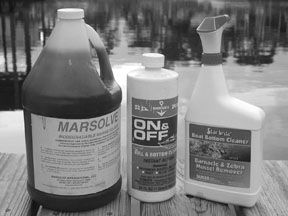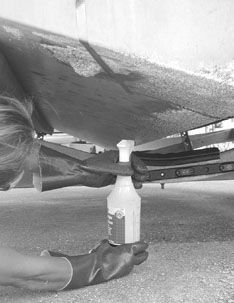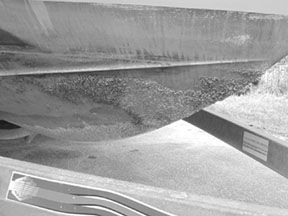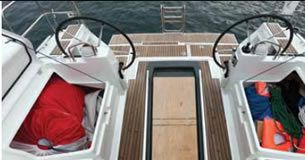In the April 1 issue of PS, we published a not-very-flattering description of a boat belonging to our friend Chris Landry, editor of Powerboat Reports, in connection with a gelcoat restorer article. We said that the 21-foot Neptune had never, to our knowledge, been cleaned, inside or out, and that it was the floating version of Oscar Madison’s bedroom. “Fish blood and rust stains, grease, grime, and dirt covered the cockpit from gunwale to gunwale. Scuffs and stains grubbed up the gelcoat, which was also chalking and fading fast…”

Et cetera. Not a pretty sight.
The situation underwater was just as bad. When Chris moved to Florida last summer, he thought he could get away with the last blush of his bottom paint, and even a few unpainted spots on the bottom. After all, he was running the boat just as hard as he had in Connecticut.
He was wrong. After only three weeks in a slip, several thick, healthy and hard clusterings of barnacles covered those bare areas.
Naturally, this was a great opportunity to test barnacle removers.
What We Tested
After scouring the marine catalogs and web, we came up with three products: Marsolve biodegradable marine solvent ($15 per gallon), Marykate On & Off Hull and Bottom Cleaner (quart: $11.99, gallon: $25.99), and Star brite Barnacle and Zebra Mussel Remover (quart: $11.99, gallon: $28.99). The Star brite product is also sold as West Marine EZ-On EZ-Off—and for a few dollars less. Marykate no longer sell its Barnacle Zebra Mussel Remover, but the company told us its Hull and Bottom Cleaner could be used on barnacles.
The winner of our barnacle-remover test back in 1998—Aqua Chem—is not currently on the market.
We ran a report on Marsolve a few years back. It’s used primarily to remove water scale, rust, and marine growth from the cooling systems of marine engines, or from water heaters. It poses no waste disposal problem because it’s biodegradable in any concentration. Marsolve also has no special ventilation or respiratory requirements—but eye protection and gloves are recommended. Use a 2:1 solution of water and Marsolve.
Marsolve claims to kill barnacles and mollusks and dissolve their shells and the glue that holds the shell to the boat or engine. It has a shelf life of about five years.

Marykate On & Off Hull and Bottom Cleaner utilizes three acids—hydrochloric, phosphoric and oxalic. It causes burns on contact; its fumes are corrosive; and it should be used in a well-ventilated area. Rubber gloves, protective clothing, and eye protection are all necessary.
The Star brite product, which contains hydrochloric acid, is just as dangerous. The same precautions are recommended.
How We Tested
The Neptune, with its bearded bow, keel and transom, was hauled and sat on its trailer for a good month or so. This allowed the barnacles to dry completely, so they would be harder to remove.
The Marykate product instructs the user to pour the product in a plastic bucket and apply it with a bristle brush. That just didn’t work for us. It was like trying to put shaving cream on the beard of Grizzly Adams. So we sprayed it on instead.
The Star brite remover says a roller, brush, or plastic sprayer can be used. The key to using all three products is to really saturate the area with barnacle remover. When working on the bottom of a boat, that means the liquid drips down, so be careful.
What We Found
The directions on the Marykate and Star brite bottles say to hose off the barnacles after they’ve been soaked with the acid. (Star brite does say that heavy barnacle growth may require several applications.) We wish this had worked, but water was no match for our tenacious cirripedes.
The Marykate and Star brite removers actually foam, bubble, and even emit smoke after being applied. They significantly softened the barnacles. But it was still necessary to use a putty knife to scrape them off. Even then, remnants of the barnacle foundations remained. These barnacles, obviously, had a good grip on the fiberglass.
With another round of acid, we were able to remove some of the barnacle foundations but some are still on the bottom and would require even more acid and scraping, or even sanding.
The Marsolve did not do as well as the acid-based removers. But it was a lot easier to work with. If working with acid scares you, Marsolve is a good alternative.

Conclusion
We realize that boats, for one reason or another, get neglected. Barnacle removers exist because, despite the great advances in bottom paints, boats still get barnacles.
Do anything you can to avoid barnacle growth on your boat. This was perhaps the nastiest job we’ve ever done—even worse than testing bottom paint strippers some years back. It’s not only nasty but dangerous. You need goggles, a hat, a mask, and heavy-duty gloves. And you should be fully clothed.
Using acid can damage the gelcoat. So can using a scraper.
We’d start out with the Marsolve cleaner because it’s less toxic. If you can’t get the barnacles off with this, then try one of the acid products—Star brite’s cleaner was slightly better than the Marykate cleaner, in our estimation.
Also With This Article
“They Secrete Glue”
Contacts
• Marykate, 631/244-8550, www.marykate.com
• Star brite, 800/327-8583, www.starbrite.com
• Marsolve, 203/359-1000, www.marsolve.com







































